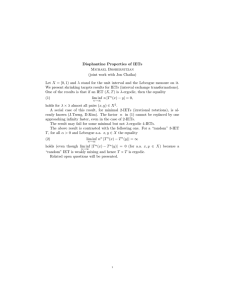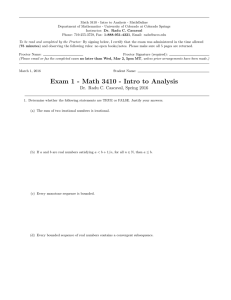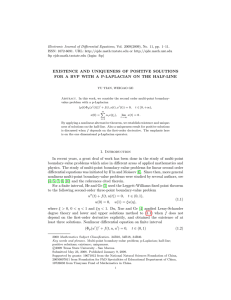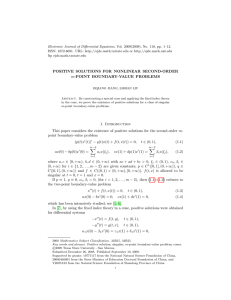Electronic Journal of Differential Equations, Vol. 2007(2007), No. 70, pp. 1–6. ISSN: 1072-6691. URL: or
advertisement
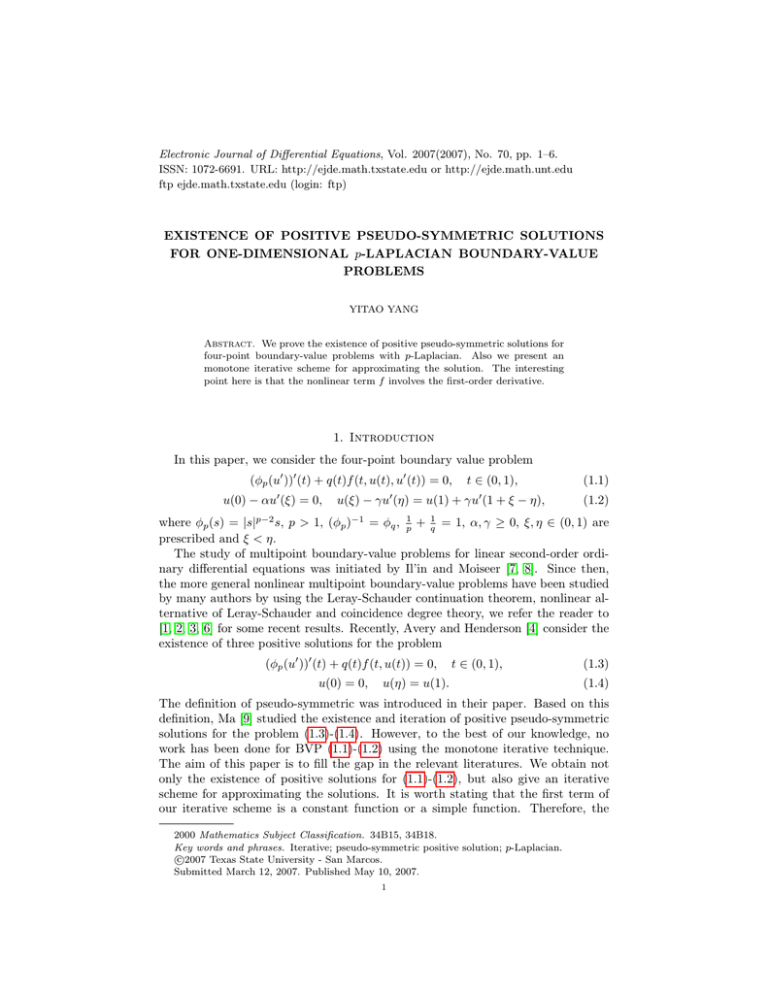
Electronic Journal of Differential Equations, Vol. 2007(2007), No. 70, pp. 1–6.
ISSN: 1072-6691. URL: http://ejde.math.txstate.edu or http://ejde.math.unt.edu
ftp ejde.math.txstate.edu (login: ftp)
EXISTENCE OF POSITIVE PSEUDO-SYMMETRIC SOLUTIONS
FOR ONE-DIMENSIONAL p-LAPLACIAN BOUNDARY-VALUE
PROBLEMS
YITAO YANG
Abstract. We prove the existence of positive pseudo-symmetric solutions for
four-point boundary-value problems with p-Laplacian. Also we present an
monotone iterative scheme for approximating the solution. The interesting
point here is that the nonlinear term f involves the first-order derivative.
1. Introduction
In this paper, we consider the four-point boundary value problem
(φp (u0 ))0 (t) + q(t)f (t, u(t), u0 (t)) = 0,
0
u(0) − αu (ξ) = 0,
0
t ∈ (0, 1),
0
u(ξ) − γu (η) = u(1) + γu (1 + ξ − η),
(1.1)
(1.2)
where φp (s) = |s|p−2 s, p > 1, (φp )−1 = φq , p1 + 1q = 1, α, γ ≥ 0, ξ, η ∈ (0, 1) are
prescribed and ξ < η.
The study of multipoint boundary-value problems for linear second-order ordinary differential equations was initiated by Il’in and Moiseer [7, 8]. Since then,
the more general nonlinear multipoint boundary-value problems have been studied
by many authors by using the Leray-Schauder continuation theorem, nonlinear alternative of Leray-Schauder and coincidence degree theory, we refer the reader to
[1, 2, 3, 6] for some recent results. Recently, Avery and Henderson [4] consider the
existence of three positive solutions for the problem
(φp (u0 ))0 (t) + q(t)f (t, u(t)) = 0,
u(0) = 0,
t ∈ (0, 1),
u(η) = u(1).
(1.3)
(1.4)
The definition of pseudo-symmetric was introduced in their paper. Based on this
definition, Ma [9] studied the existence and iteration of positive pseudo-symmetric
solutions for the problem (1.3)-(1.4). However, to the best of our knowledge, no
work has been done for BVP (1.1)-(1.2) using the monotone iterative technique.
The aim of this paper is to fill the gap in the relevant literatures. We obtain not
only the existence of positive solutions for (1.1)-(1.2), but also give an iterative
scheme for approximating the solutions. It is worth stating that the first term of
our iterative scheme is a constant function or a simple function. Therefore, the
2000 Mathematics Subject Classification. 34B15, 34B18.
Key words and phrases. Iterative; pseudo-symmetric positive solution; p-Laplacian.
c
2007
Texas State University - San Marcos.
Submitted March 12, 2007. Published May 10, 2007.
1
2
Y. YANG
EJDE-2007/70
iterative scheme is significant and feasible. At the same time, we give a way to find
the solution which will be useful from an application viewpoint.
We consider the Banach space E = C 1 [0, 1] equipped with norm
kuk := max{kuk0 , ku0 k0 },
where kuk0 = max0≤t≤1 |u(t)|, ku0 k0 = max0≤t≤1 |u0 (t)|. In this paper, a positive
solution u(t) of BVP (1.1), (1.2) means a solution u(t) of (1.1), (1.2) satisfying
u(t) > 0, for 0 < t < 1.
We recall that a function u is said to be concave on [0, 1], if
u(λt2 + (1 − λ)t1 ) ≥ λu(t2 ) + (1 − λ)u(t1 ),
t1 , t2 , λ ∈ [0, 1].
Definition 1.1. For ξ ∈ (0, 1) a function u ∈ E is said to be pseudo-symmetric if u
is symmetric over the interval [ξ, 1]. That is, for t ∈ [ξ, 1] we have u(t) = u(1+ξ −t).
Remark 1.2. For ξ ∈ (0, 1), if u ∈ E is pseudo-symmetric, we have u0 (t) =
−u0 (1 + ξ − t), t ∈ [ξ, 1].
Define the cone K of E as
K = {u ∈ C 1 [0, 1] : u(t) ≥ 0, u is concave on[0, 1] and u is symmetric on [ξ, 1]}.
For x, y in K a cone of E, recall that x ≤ y if y − x ∈ K.
In the rest of the paper, we make the following assumptions:
(H1) q(t) ∈ L1 [0, 1] is nonnegative and q(t) = q(1 + ξ − t), a.e. t ∈ [ξ, 1], and
q(t) 6≡ 0 on any subinterval of [0,1];
(H2) f ∈ C([0, 1]×[0, ∞)×R, [0, ∞)) and f (t, x, y) = f (1+ξ−t, x, −y), (t, x, y) ∈
[ξ, 1] × [0, ∞) × R. Moreover, f (t, ·, y) is nondecreasing for (t, y) ∈ [0, ξ+1
2 ]×
ξ+1
R, f (t, x, ·) is nondecreasing for (t, x) ∈ [0, 2 ] × [0, ∞).
2. Existence Result
Lemma 2.1 ([9]). Each u ∈ K satisfies the following properties:
2
(i) u(t) ≥ 1+ξ
kuk0 min{t, 1 + ξ − t}, t ∈ [0, 1];
2ξ
1+ξ kuk0 ,
kuk0 = u( 1+ξ
2 ).
(ii) u(t) ≥
(iii)
t ∈ [ξ, 1+ξ
2 ];
For x ∈ K, we define a mapping T : K → E given by
R 1+ξ
2
q(τ )f (τ, x(τ ), x0 (τ ))dτ )
αφ
(
q
R ξ R 1+ξ
t
+ φ ( 2 q(τ )f (τ, x(τ ), x0 (τ ))dτ )ds, 0 ≤ t ≤ 1+ξ
2 ,
0 q s
1+ξ
R
(T x)(t) = αφ ( 2 q(τ )f (τ, x(τ ), x0 (τ ))dτ )
q ξ
Rξ
R 1+ξ
+ 0 φq ( s 2 q(τ )f (τ, x(τ ), x0 (τ ))dτ )ds
+ R 1 φ (R s q(τ )f (τ, x(τ ), x0 (τ ))dτ )ds,
1+ξ
1+ξ
q
2 ≤ t ≤ 1.
t
(2.1)
2
Obviously, T x ∈ E, and we can prove T x is a solution of the boundary-value
problem
(φp (u0 ))0 (t) + q(t)f (t, x(t), x0 (t)) = 0,
0
u(0) − αu (ξ) = 0,
0
t ∈ (0, 1),
0
u(ξ) − γu (η) = u(1) + γu (1 + ξ − η).
Therefore, each fixed point of T is a solution of problem (1.1)-(1.2).
(2.2)
(2.3)
EJDE-2007/70
EXISTENCE OF POSITIVE PSEUDO-SYMMETRIC SOLUTIONS
3
Lemma 2.2. Suppose (H1), (H2) hold, then T : K → K is completely continuous
and nondecreasing.
1+ξ
Proof. For t ∈ [ξ, 1+ξ
2 ], we have 1 + ξ − t ∈ [ 2 , 1]. Therefore,
(T x)(1 + ξ − t)
Z
Z 1+ξ
2
q(τ )f (τ, x(τ ), x0 (τ ))dτ ) +
= αφq (
1
Z
φq (
+
1+ξ−t
Z
= αφq (
+
t
q(τ )f (τ, x(τ ), x0 (τ ))dτ )ds
Z
0
ξ
Z
φq (
q(τ )f (τ, x(τ ), x (τ ))dτ ) +
0
ξ
q(τ )f (τ, x(τ ), x0 (τ ))dτ )ds
s
1+ξ
2
1+ξ
2
1+ξ
2
Z
φq (
1+ξ
2
s
ξ
Z
Z
φq (
0
ξ
Z
ξ
1+ξ
2
q(τ )f (τ, x(τ ), x0 (τ ))dτ )ds
s
q(τ )f (τ, x(τ ), x0 (τ ))dτ )ds
s
Z
= αφq (
1+ξ
2
Z
0
q(τ )f (τ, x(τ ), x (τ ))dτ ) +
ξ
t
Z
φq (
0
1+ξ
2
q(τ )f (τ, x(τ ), x0 (τ ))dτ )ds
s
= (T x)(t).
(2.4)
So that, T x is symmetric on [ξ, 1] with respect to 1+ξ
.
Obviously,
(T
x)(t)
≥
0,
Tx
2
is concave on [0, 1]. Therefore, T : K → K. It is easy to see that T : K → K is
completely continuous.
For x1 (t), x2 (t) ∈ K and x1 (t) ≤ x2 (t), thus x2 (t) − x1 (t) ∈ K. So that x02 (t) −
1+ξ
0
0
0
x1 (t) ≥ 0, t ∈ [0, 1+ξ
2 ] and x2 (t) − x1 (t) ≤ 0, t ∈ [ 2 , 1]. Assumption (H2) implies
(T x1 )(t) ≤ (T x2 )(t).
Lemma 2.3 ([5]). Let u0 , v0 ∈ E, u0 < v0 and T : [u0 , v0 ] → E be an increasing
operator such that
u0 ≤ T u0 , T v0 ≤ v0 .
Suppose that one of the following conditions is satisfied:
(C1) K is normal and T is condensing;
(C2) K is regular and T is semicontinuous, i.e., xn → x strongly implies T xn →
T x weakly.
Then T has a maximal fixed point x∗ and a minimal fixed point x∗ in [u0 , v0 ];
moreover
x∗ = lim vn , x∗ = lim un ,
n→∞
n→∞
where vn = T vn−1 , un = T un−1 (n = 1, 2, 3, . . . ), and
u0 ≤ u1 ≤ · · · ≤ un ≤ · · · ≤ vn ≤ · · · ≤ v1 ≤ v0 .
Denote the positive quantities
Z 1+ξ
Z
2
A = 1/ max αφq (
q(τ )dτ ) +
ξ
1+ξ
2
Z
φq (
0
1+ξ
2
Z
q(τ )dτ )ds, φq (
s
1+ξ
2
q(τ )dτ ) ,
0
(2.5)
Z
B = 1/
ξ
1+ξ
2
Z
φq (
s
1+ξ
2
q(τ )dτ )ds.
(2.6)
4
Y. YANG
EJDE-2007/70
Theorem 2.4. Assume (H1), (H2) hold. If there exist two positive numbers a, b
2b
with 1+ξ
< a, such that
sup f (t, a, a) ≤ φp (aA),
inf
t∈[ξ, 1+ξ
2 ]
t∈[0,1]
f (t,
2ξb
, 0) ≥ φp (bB).
1+ξ
(2.7)
Then, (1.1)-(1.2) has at least one positive pseudo-symmetric solution υ ∗ ∈ K with
b ≤ kυ ∗ k0 ≤ a,
where υ0 (t) =
2b
1+ξ
0 ≤ k(υ ∗ )0 k0 ≤ a,
lim T n υ0 = υ ∗ ,
n→∞
min{t, 1 + ξ − t}, t ∈ [0, 1].
Proof. We denote K[b, a] = {ω ∈ K : b ≤ kωk0 ≤ a, 0 ≤ kω 0 k0 ≤ a}. Next, we
first prove T K[b, a] ⊂ K[b, a]. Let ω ∈ K[b, a], then 0 ≤ ω(t) ≤ maxt∈[0,1] ω(t) ≤
kωk0 ≤ a,
t ∈ [0, 1], 0 ≤ ω 0 (t) ≤ maxt∈[0,1] |ω 0 (t)| = kω 0 k0 ≤ a, t ∈ [0, 1+ξ
2 ]. By lemma 2.1
2ξ
2ξb
(ii), mint∈[ξ, 1+ξ ] ω(t) ≥ 1+ξ
kωk0 ≥ 1+ξ
, mint∈[ξ, 1+ξ ] ω 0 (t) ≥ ω 0 ( 1+ξ
2 ) = 0. So, by
2
2
assumption (2.7), we have
1+ξ
], (2.8)
0 ≤ f (t, ω(t), ω 0 (t)) ≤ f (t, a, a) ≤ sup f (t, a, a) ≤ φp (aA), t ∈ [0,
2
t∈[0,1]
f (t, ω(t), ω 0 (t)) ≥ f (t,
2ξb
2ξb
, 0) ≥ inf f (t,
, 0) ≥ φp (bB),
1+ξ
1
+ξ
t∈[ξ, 1+ξ
]
2
t ∈ [ξ,
1+ξ
].
2
(2.9)
By lemma 2.2, we know T ω ∈ K. So, lemma 2.1 (iii) implies kT ωk0 = (T ω)( 1+ξ
2 ).
As a result,
kT ωk0
1+ξ
)
2
= (T ω)(
Z
= αφq (
1+ξ
2
Z
0
1+ξ
2
q(τ )f (τ, x(τ ), x (τ ))dτ ) +
ξ
0
Z
≤ aA(αφq (
1+ξ
2
1+ξ
2
Z
q(τ )dτ ) +
ξ
1+ξ
2
q(τ )f (τ, x(τ ), x0 (τ ))dτ )ds
s
1+ξ
2
Z
φq (
0
Z
φq (
q(τ )dτ )ds) ≤ a;
s
k(T ω)0 k0 = (T ω)0 (0)
Z 1+ξ
2
= φq (
q(τ )f (τ, x(τ ), x0 (τ ))dτ )
0
1+ξ
2
Z
≤ aAφq (
q(τ )dτ ) ≤ a;
0
kT ωk0 = (T ω)(
Z
1+ξ
2
≥
1+ξ
)
2
Z 1+ξ
2
φq
q(τ )f (τ, x(τ ), x0 (τ ))dτ ds
ξ
s
Z
≥ bB
1+ξ
2
φq
ξ
Z
s
1+ξ
2
q(τ )dτ ds = b.
EJDE-2007/70
EXISTENCE OF POSITIVE PSEUDO-SYMMETRIC SOLUTIONS
5
Thus, b ≤ kT ωk0 ≤ a, 0 ≤ k(T ω)0 k0 ≤ a, which implies T K[b, a] ⊂ K[b, a].
0
2b
2b
Let υ0 (t) = 1+ξ
min{t, 1 + ξ − t}, t ∈ [0, 1], then kυ0 k0 = b and kυ0 k0 = 1+ξ
< a,
so υ0 ∈ K[b, a]. Let υ1 = T υ0 , then υ1 ∈ K[b, a], we denote
υn+1 = T υn = T n+1 υ0 ,
(n = 0, 1, 2, . . . ).
(2.10)
Since T K[b, a] ⊂ K[b, a], we have υn ∈ K[b, a], (n = 0, 1, 2, . . . ). From υ1 ∈ K[b, a],
thus
υ1 (t) ≥
2b
2
kυ1 k0 min{t, 1 + ξ − t} ≥
min{t, 1 + ξ − t} = υ0 (t),
1+ξ
1+ξ
t ∈ [0, 1],
which implies T υ0 ≥ υ0 . K is normal and T is completely continuous. By Lemma
2.3, we have T has a fixed point υ ∗ ∈ K[b, a]. Moreover, υ ∗ = limn→∞ υn . Since
kυ ∗ k0 ≥ b > 0 and υ ∗ is a nonnegative concave function on [0, 1], we conclude
that υ ∗ (t) > 0, t ∈ (0, 1). Therefore, υ ∗ is a positive pseudo-symmetric solution of
(1.1)-(1.2).
Corollary 2.5. Assume (H1),(H2) hold. If
lim sup
l→0
inf
t∈[ξ, 1+ξ
2 ]
particularly, lim supl→0 inf t∈[ξ, 1+ξ ]
2
f (t, l, 0)
1+ξ
≥ φp (
B),
φp (l)
2ξ
f (t,l,0)
φp (l)
lim inf sup
l→+∞ t∈[0,1]
particularly, lim inf l→+∞ supt∈[0,1]
(2.11)
= +∞,
f (t, l, l)
≤ φp (A),
φp (l)
f (t,l,l)
φp (l)
(2.12)
= 0. Where A, B are defined as (2.5),
2b
(2.6). Then there exist two positive numbers a, b with 1+ξ
< a, such that problem
(1.1), (1.2) has at least one positive pseudo-symmetric solution υ ∗ ∈ K with
b ≤ kυ ∗ k0 ≤ a, 0 ≤ k(υ ∗ )0 k0 ≤ a, lim T n υ0 = υ ∗ ,
n→∞
where υ0 (t) =
2b
1+ξ
min{t, 1 + ξ − t}, t ∈ [0, 1].
Remark 2.6. Problem (1.1)-(1.2) may have two positive pseudo-symmetric solutions ω ∗ , υ ∗ ∈ K, if we make another iteration by choosing ω0 (t) = a and
ωn = limn→∞ T n ω0 = ω ∗ . However, ω ∗ and υ ∗ may be the same solution.
Example 2.7. We consider the problem
(|u0 |3 u0 )0 (t) +
1
0
2
2
t ∈ (0, 1),
1 [(u (t)) + ln((u(t)) + 1)] = 0,
− t) 2
1
1
1
5
u(0) − 2u0 ( ) = 0, u( ) − 3u0 ( ) = u(1) + 3u0 ( ).
3
3
2
6
t
1
2
( 43
(2.13)
(2.14)
We notice that p = 5, α = 2, ξ = 31 , γ = 3, η = 12 . Obviously, f (t, u, u0 ) =
(u0 (t))2 +ln((u(t))2 +1) is nondecreasing for (t, u0 ) ∈ [0, 23 ]×R, f (t, u, u0 ) = (u0 (t))2 +
ln((u(t))2 + 1) is nondecreasing for (t, u) ∈ [0, 32 ] × [0, ∞), q(t) = 1 41 1 is
t 2 ( 3 −t) 2
nonnegative and pseudo-symmetric about 32 . So, conditions (H1),(H2) are satisfied.
6
Y. YANG
EJDE-2007/70
On the other hand,
lim sup
l→0
f (t, l, 0)
ln(l2 + 1)
= ∞,
= lim sup inf
1 2
φp (l)
l4
t∈[ξ, 1+ξ
l→0 t∈[ 3 , 3 ]
2 ]
inf
f (t, l, l)
l2 + ln(l2 + 1)
= 0.
= lim inf sup
l→+∞ t∈[0,1]
l4
t∈[0,1] φp (l)
lim inf sup
l→+∞
Therefore, from Corollary 2.5, it follows that (2.13)-(2.14) has at least one positive
pseudo-symmetric solution.
References
[1] R. P. Agarwal and D. O’Regan; Nonlinear boundary-value problems on time scales, Nonlinear
Anal. 44 (2001), 527-535.
[2] R. P. Agarwal and D. O’Regan; Lidstone continuous and discrete boundary-value problems,
Mem. Diff. Equ. Math. Phys. 19 (2000), 107-125.
[3] R. P. Agarwal, H. Lü and D. O’Regan; Positive solutions for the boundary-value problem
(|u00 |p−2 u00 ) − λq(t)f (u(t)) = 0, Mem. Diff. Equ. Math. Phys. 28 (2003), 33-44.
[4] R. I. Avery, J. Henderson; Existence of three positive pseudo-symmetric solutions for a onedimensional p-laplacian, J. Math. Anal. Appl. 277 (2003), 395-404.
[5] D. Guo, V. Lakshmikantham; Nonlinear problems in abstrat cone, Academic Press, Sandiego,
1988.
[6] X. He, W. Ge; A remark on some three-point boundary value problem for the one-dimensional
p-laplacian, ZAMM. 82 (2002), 728-731.
[7] V. A. Il’in, E. I. Moiseer; Nonlocal boundary value problem of the first kind for a sturmliouville operator in its differential and finite difference aspects, Differential Equations. 23
(1987), 803-810.
[8] V. A. Il’in, E. I. Moiseer; Nonlocal boundary value problem of the second kind for a sturmliouville operator, Differential Equations. 23 (1987), 979-987.
[9] Dexiang Ma, Weigao Ge; Existence and iteration of positive pseudo-symmetric solutions
for a three-point second-order p-Laplacian BVP, Appl. Math. Lett. (2007), doi: 10.1016
j.aml.2006.05.025.
Yitao Yang
Institute of Automation, Qufu Normal University, Qufu, Shandong 273165, China
E-mail address: yitaoyangqf@163.com



